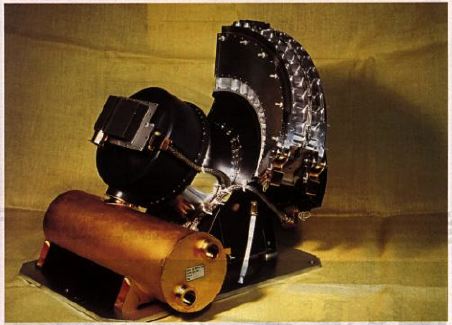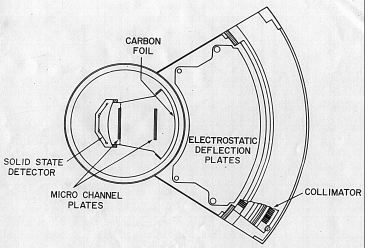SWICS Instrument Description

The above picture shows the Solar Wind Ion Composition
Spectrometer (SWICS) instrument. The top of the fan shaped portion on the upper right of the photo is the mechanical collimator with protective cover in place (this
cover swung open after launch). Immediately below the collimator is the electrostatic deflection array. The cylindrical portion in the middle contains
the analog and digital electronics, the sensor power supplies, the solid state
detector (auxiliary channel), and the time-of-flight system (main channel). Topping that section is the
opto-coupler box that transmits signals to the DPU (data processing unit) across a vacuum gap between
inner and outer housings. The gold plated cylinder on the left of the
instrument is the 30 kV power supply.

SWICS has two channels for analyzing the solar wind ions. The main channel identifies particles using a combination of electrostatic deflection,
post-acceleration, time-of-flight (TOF), and residual energy measurement. Both channels use the electrostatic analyzer, which consists of a mechanical collimator followed by an electrostatic deflection system to select ions by their energy-per-charge. The deflection
system uses 64 logarithmic voltage steps to cover an energy-per-charge range 0.16 to 14 keV/e and 0.6 to 60 keV/e, for the auxiliary
and main channels, respectively. The electrostatic analyzer also contains the
light traps that serve to block UV and visible radiation.
Before entering the TOF/Energy telescope (main channel) or the Energy-only telescope (auxiliary
channel), the ions see a ~23 kV drop in potential across the inner and outer shells of the cylindrical housing, thereby accelerating most positively charged ions to energies above the solid state detector (SSD) thresholds and allowing an energy measurement. The main channel ions enter the TOF telescope by passing through a carbon foil, producing secondary electrons that are detected by the start microchannel plate (MCP). The ions then travel the 10 cm length of the telescope and hit one of three Au-Si solid state detectors, which emits secondary electrons collected by the stop MCP. If the ion is energetic enough to trip the SSD threshold, the SSD provides a residual energy measurement. With the time-of-flight, the residual energy, and the energy-per-charge (from the deflection system), the ion can be identified by the calculated mass and mass-per-charge. If an energy measurement is not possible (i.e., the ion's residual energy is not above the SSD threshold), only a mass-per-charge calculation is made. The auxiliary channel consists of an SSD and yields counting rates as a function of energy-per-charge.

A top view of the SWICS instrument showing the cross section of
the time-of-flight telescope with the three solid-state detectors, the
microchannel plate start and stop detectors, and the curved carbon foil. The collimator vanes are shown in the cut-away view at the bottom
right.

Above is the functional block diagram of SWICS. The heavy bordered boxes show
the separate components that make up the instrument: the data processing unit
(DPU), the sensor, and the post-acceleration power supply (PAPS). Inside each
unit are schematics of each subsystem and the institutions that were responsible for the
components. Arrows show flow of ions, signals, and power among the
subsystems.
Diagrams from and text based on The Solar Wind Ion Composition Spectrometer, Gloeckler et al. (Astron. Astrophys. Suppl. Ser., 92, 1992). For a more detailed description of the SWICS experiment, reading of this paper is suggested.
Back to Table of Contents
This page authored by Jeff Miller, University of Maryland Space Physics with suggestions from Dr. Toni Galvin and Dr. Chris Cohen, both also at University of Maryland Space Physics. It was last updated May 7, 2003. If you have any comments, suggestions, or have a URL that you think should go onto this page, please send them to Scott Lasley.




